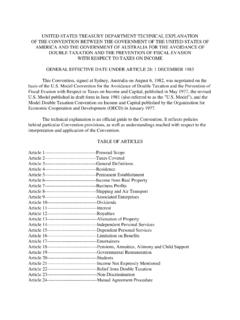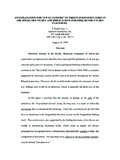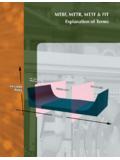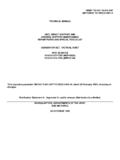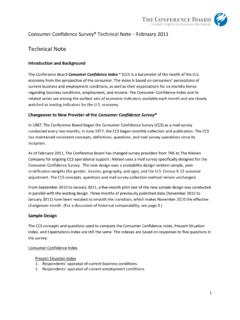Transcription of TECHNICAL EXPLANATION OP THE CONVENTION …
1 TECHNICAL EXPLANATION OP THE CONVENTION BETWEENTHE GOVERNMENT OF THE UNITED STATES OF AMERICAAND THE GOVERNMENT OF THE STATE OF ISRAEL WITH RESPECT TO TAXES ONINCOME, SIGNED AT WASHINGTON, ON NOVEMBER 20, 1975, AS AMENDEDBY A PROTOCOL SIGNED AT WASHINGTON, ON MAY 30, 1980 GENERAL EFFECTIVE DATE UNDER ARTICLE 31: 1 JANUARY 1995 INTRODUCTIONThis is a TECHNICAL EXPLANATION of the CONVENTION between the United States and Israel,signed on November 20, 1975, as amended by a Protocol signed on May 30, 1980, ( theConvention ). This EXPLANATION is an official guide to the CONVENTION . It reflects policies behindparticular CONVENTION provisions, as well as understandings reached with respect to theinterpretation and application of the OF ARTICLESA rticle 1----------------------------------Taxes CoveredArticle 2----------------------------------Gener al DefinitionsArticle 3----------------------------------Fisca l ResidenceArticle 4----------------------------------Sourc e of IncomeArticle 5----------------------------------Perma nent EstablishmentArticle 6----------------------------------Gener al Rules of TaxationArticle 7----------------------------------Incom e from Real PropertyArticle 8----------------------------------Busin ess ProfitsArticle 9----------------------------------Shipp ing and Air TransportArticle 10--------------------------------Grants Article 11--------------------------------Relate d PersonsArticle 12--------------------------------Divide ndsArticle 13--------------------------------Intere stArticle 14--------------------------------Royalt iesArticle
2 15--------------------------------Capita l GainsArticle 15-A-----------------------------Charita ble ContributionsArticle 16--------------------------------Indepe ndent Personal ServicesArticle 17--------------------------------Depend ent Personal ServicesArticle 18--------------------------------Public EntertainersArticle 19--------------------------------Amount s Received for Furnishing Personal Servicesof OthersArticle 20--------------------------------Privat e Pensions and AnnuitiesArticle 21--------------------------------Social Security PaymentsArticle 22--------------------------------Govern mental FunctionsArticle 23--------------------------------Teache rsArticle 24--------------------------------Studen ts and TraineesArticle 25--------------------------------Invest ment or Holding CompaniesArticle 26--------------------------------Relief from Double TaxationArticle 27--------------------------------Nondis criminationArticle 28--------------------------------Mutual Agreement ProcedureArticle 29--------------------------------Exchan ge of InformationArticle 30--------------------------------Diplom atic and Consular OfficersArticle 31--------------------------------Entry into ForceArticle 32--------------------------------Termin ationExchanges of Notes (Protocol 1)-----of 30 May, 1980 Protocol 2-------------------------------of 26 January, 1993 Exchange of Notes (Protocol 2)------of 26 January, 1993 ARTICLE 1 Taxes CoveredParagraph (1) designates the taxes of the Contracting States which are the subject of theConvention.
3 With respect to the United States, the subject taxes are the Federal income taxesimposed by the Internal Revenue Code ( Code ). The CONVENTION also applies to the excise taxon insurance premiums paid to foreign insurers, under section 4371 of the Code. However, theexcise tax on insurance premiums is covered only to the extent that the foreign insurer does notreinsure the risks, directly or indirectly, with a person who is not entitled to exemption from suchtax under this or another United States tax CONVENTION . This limitation on coverage is intended toclarify that persons not entitled to the benefits of this or another CONVENTION may not use aninsurer in Israel as a conduit for the purpose of obtaining CONVENTION benefits. Moreover, asprovided by paragraph (5) of Article 6 (General Rules of Taxation). The United States reservesthe right to impose taxes under Code sections 531 (accumulated earnings tax) and 541 (personalholding company tax), except as provided in such paragraph (5).
4 United States taxes not generally covered by the CONVENTION include the estate, gift andgeneration skipping transfer taxes, the Windfall Profits Tax, Federal unemployment taxes andsocial security taxes imposed under sections 1401, 3101 and 3111 of the the case of Israel, paragraph (1) provides that the CONVENTION applies to the income tax(including capital gains tax); the company tax; the tax on gains from the sale of land under theland appreciation tax law; the tax on profits levied on banking institutions and insurancecompanies under the Value Added Tax Law; and compulsory loans made with respect to taxableyears ending before April 1, 1988, with respect to corporations that became subject theretobefore April 1, 1977. This reflects the fact that compulsory loans are being phased-out fromIsraeli law. See the discussion of Article 26 (Relief from Double Taxation) for an analysis of thetreatment of these compulsory loans for purposes of the United States foreign tax to paragraph (2), the CONVENTION will also apply to taxes substantially similar tothose covered by paragraph (1) which are imposed in addition to, or in place of, existing incometaxes, after November 20, 1975 (the date of signature of the CONVENTION ).
5 Under paragraph (3), for purposes of Article 27 (Nondiscrimination), the Conventionapplies to taxes of every kind imposed at the national (4) provides that the competent authority of each Contracting State will notifythe competent authority of the other Contracting State of any substantial amendment of the taxlaws referred to in paragraph (1), or of the adoption of substantially similar taxes imposed inaddition to, or in place of, those taxes by transmitting the texts of such amendments or (5) provides for a similar exchange with respect to the publication of materialconcerning the application of the CONVENTION , whether in the form of regulations, rulings orjudicial 2 General DefinitionsParagraph (1) sets out definitions of certain basic terms used in the CONVENTION . Unlessthe context otherwise requires, the terms defined in this paragraph have a uniform meaningthroughout the CONVENTION . A number of important terms, however, are defined elsewhere in term United States means the United States of America.
6 When used in ageographical sense, the term means the states of the United States and the District of , the CONVENTION does not apply to the possessions of the United States or theCommonwealth of Puerto Rico. The term Israel means the State of used in a geographical sense, the terms United States and Israel also includetheir respective territorial seas, and in general accord with the principles of section 638 of theCode, their respective continental term Contracting State is defined to mean the United States or Israel as the contextrequires. The term State means the United States, Israel, or any other national term person is defined as including an individual, a partnership, a corporation, anestate or a term United States corporation is defined as a corporation, or any unincorporatedentity which is treated as a corporation for United States tax purposes, which is created ororganized under the laws of the United States, any state thereof, or the District of Columbia.
7 AnIsraeli corporation is defined as any body of persons taxed as a body of persons resident in Israelunder its income tax ordinance. Thus, for example, a corporation incorporated in a State otherthan a Contracting State which is taxed by Israel as a body of persons resident in Israel will be anIsraeli corporation for purposes of the CONVENTION . See, however, the discussion of paragraph (3)of Article 3 (Fiscal Residence) for the treatment of a corporation which is both resident of theUnited States and a resident of respect to the United States, the term competent authority means the Secretary ofthe Treasury or his delegate. With respect to Israel, it means the Minister of Finance or hisdelegate. The term tax means those taxes imposed by the United States or Israel to which theConvention applies by virtue of Article 1 (Taxes Covered).The term international traffic is defined as any voyage of a ship or aircraft operated bya resident of one of the Contracting States except where such voyage is confined solely to placeswithin a Contracting State.
8 Thus, for example, coastal shipping along the Atlantic coast of theUnited States is not a voyage in international traffic. However, if a ship operated by a resident ofIsrael transports goods from Canada to the United States, leaving some of the goods in NewYork and the remainder in Norfolk, the portion of the voyage between New York and Norfolk isinternational (2) provides that any term used in the CONVENTION which is not defined thereinshall, unless the context otherwise requires, have the meaning which it has under the laws of theContracting State whose tax is being determined. However, where a term has a different meaningunder the laws of Israel and the United States or where the meaning under the laws of one of theContracting States is not readily determinable, the competent authorities may for purposes of theConvention establish a common meaning, which may differ from the meaning under the laws ofeither or both Contracting States, in order to prevent double taxation or to further any otherpurpose of the 3 Fiscal ResidenceThis Article sets forth rules for determining the residence of individuals, corporations,and other persons for purposes of the CONVENTION .
9 Residence is important because, in general,only a resident of one of the Contracting States may qualify for the benefits of the CONVENTION . Aperson who, under the respective taxation laws of the Contracting States, is a resident of oneContracting State and not the other need look no further to determine his residence under theConvention. However, where a person is a resident of each of the Contracting States under itslaws, paragraphs (2) and (3) of the Article must be used to determine that person's residence forpurposes of the CONVENTION . The CONVENTION definition is, of course, exclusively for purposes ofthe paragraph (1), the term resident of Israel means an Israeli corporation (asdefined in Article 2 (General Definitions)) or any other person (except a corporation or anyentity treated under Israeli law as a corporation) resident in Israel for purposes of Israeli , resident of the United States means a United States corporation (as defined in Article 2(General Definitions)) and any other person (except a corporation or any entity treated as acorporation for United States tax purposes) resident in the United States for purposes of UnitedStates tax.
10 Thus, a resident of the United States includes a resident alien individual, an alienpresent in the United States who elects to be treated as a resident under Code section 6013(g) or(h), and a resident citizen, but under no circumstances, a foreign corporation. A citizen of theUnited States or Israel is not automatically a resident of the United States or Israel for purposesof this CONVENTION . Whether a citizen of the United States is a resident of the United States forthis purpose is to be determined by the principles of the Treasury regulations issued under Codesection CONVENTION provides that a partnership, estate, or trust is a resident of a ContractingState only to the extent that the income derived by such person is subject to tax in suchContracting State as the income of a resident. For example, under United States law, apartnership is never, and an estate or trust is often not, taxed as such. Under the CONVENTION , inthe case of the United States, income received by a partnership, estate, or trust will not qualifyfor the benefits of the CONVENTION unless such income is subject to tax in the United States as theincome of a resident.










